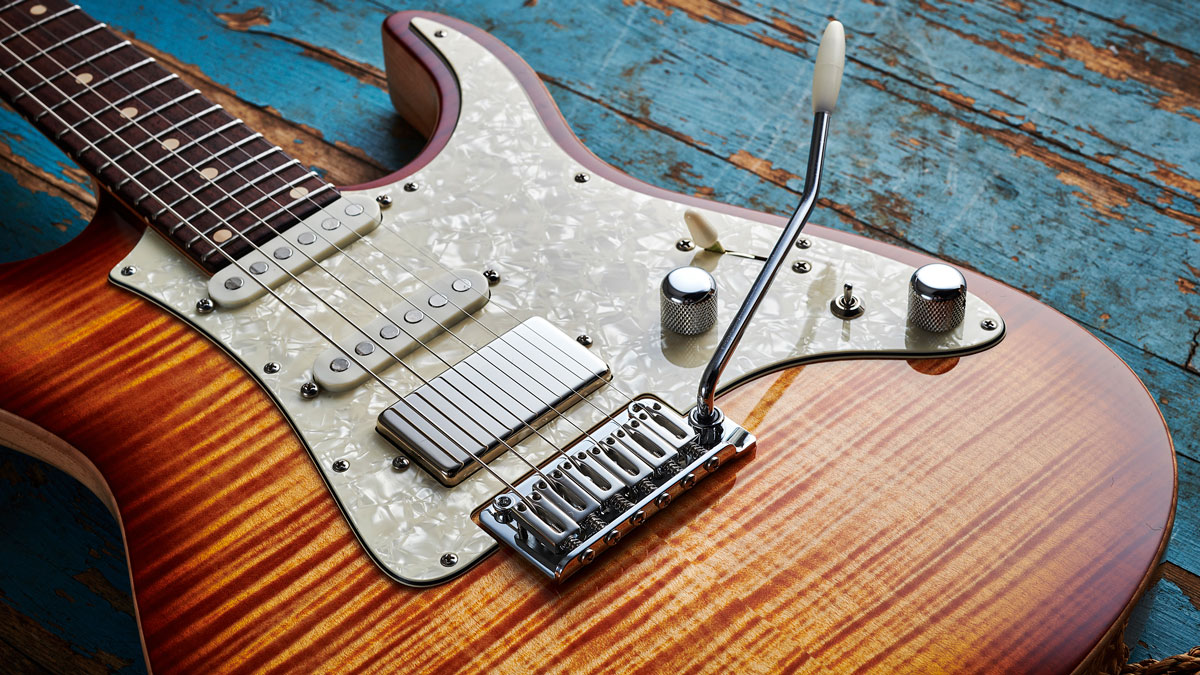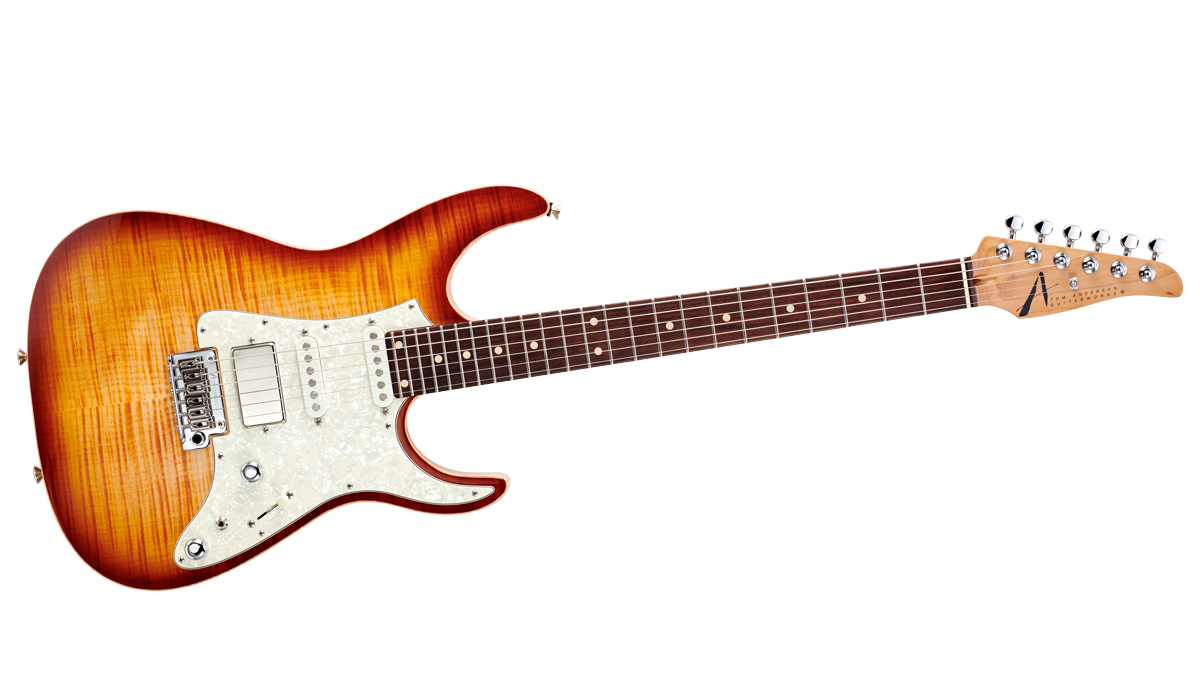MusicRadar Verdict
if you secretly hanker for a musical wolf in sheep’s clothing then the Guardian Angel could well be that perfect devil in disguise.
Pros
- +
Superbly crafted.
- +
Cleverly styled.
- +
Brimming with sensible options that add to the playing experience - the complete guitar!
Cons
- -
It’s a lot of money, but check its price against the competitors.
MusicRadar's got your back
Anyone who goes back far enough will remember the impact that Dave Schecter’s products had on the replacement parts market.
From hardware to woodwork, his top-class wares opened our eyes to the fact that we could customise and ‘improve’ our stock instruments. Schecter went on to create fine guitars alongside a fresh young lad named Tom Anderson. After seven years with Schecter, and encouraged by his mentor, Tom went his own way. Initially building necks, bodies and pickups, he ultimately realised that creating entire guitars was more rewarding. Over 30 years on and he’s still making some of the world’s most stunning instruments - the Guardian Angel is one of his latest creations.
Freshly developed from the ground up, it’s a purpose-built 24-fretter - essentially a Drop Top Classic with a full two-octave complement. But you can’t simply tack on two frets to turn a 22-fret guitar into a 24 because the instrument’s entire geometry is thrown out of kilter, so every component must be optimised so as not to lose the essence. With this in mind, Anderson rebalanced the body dimensions in order to make the pickups sit in the perfect position to extract the best possible sounds, and deepened the cutaways to effect total access.
When you look at an Anderson you probably think it’s a cool modern take on the classic Californian three-pickup double-cut. But you’d be staggered at how much extra is going on here. The ‘drop top’, itself an Anderson innovation, means the flamed maple cap is bent over the contoured body base (in this case, lightweight swamp ash) and not a flat lump with the contour carved off it, which in these days of ecological awareness is less wasteful of the more exotic timber.
But the big leap forward is in the neck join. Anderson calls it the A-Wedgie. Unlike the traditional ‘open on one side’ neck joint pioneered by Fender, using four large wood screws to hold it in place and keep string alignment stable, Anderson has created a spectacular joint using an A-shape tenon that locks the heel into its socket and requires just two threaded bolts (screwed into metal ferrules) to keep it rock solid. It’s something you look at and think, ‘Why didn’t anyone do that before?’ It’s a stunning piece of engineering that hugs the neck to the body for maximum sound transfer and sets Anderson way above the pack.

While on environmental issues, the finish also merits a mention. We talk of the ‘breathability’ of nitrocellulose; in reality, synthetic base coats are often applied to stop sinking and to create a flat platform on which to spray it. Anderson holds no truck with nitro, instead opting for a UV cure, ultra-thin finish that he reckons is just as breathable as cellulose but immensely more planet-friendly. The body is gloss, while the maple neck comes in Anderson’s satin caramel finish and looks stunning.
Tom and his team have even researched the best possible fret material for tone and durability, and concluded that stainless steel takes the top spot. Although he says that in most listening tests there’s usually no discernible difference, when a bat-eared individual does notice something, it’s usually a tad more robustness. Needless to say, these medium jumbo frets are fitted and dressed impeccably.
Want all the hottest music and gear news, reviews, deals, features and more, direct to your inbox? Sign up here.
Something for which Anderson has long been famous is his electronics and switching. The idea is to offer a host of extra tones with minimum complication. Our Guardian Angel comes with the Add Bridge/Splitter and VA Boost options. The Add Bridge pull-switch does exactly what it says: lifting the tone knob brings in the bridge humbucker when the main five-way is set to the neck, or neck and middle positions. It’s a simple way to get both outside pickups on, or to kick in all three at once. The VA Boost’s 4dB extra lift may not sound like much, but it’s just enough to crank the guitar’s output to the next level. It’s a three-way mini that: in the down position boosts all pickups; in the middle gives full boosted humbucker only; and flipped up splits it. Those two simple mods offer almost all imaginable tone choices without the need for a degree in nuclear physics.
Hardware includes Anderson’s own design two-point ‘vintage’ vibrato, locking tuners and, of course, twin strap buttons at the base to keep the guitar stable when lent against an amp. Fit and finish are, as you would expect at over three-and-a-half grand, flawless.
Feel and Sounds
Coming in at bang on 7lbs (3.175kg), the Guardian Angel is a breeze to sling around the neck and its remodelled styling sits everything in the expected place: no overly protruding or too-far-in neck - the 12th fret is just where you expect it to be. The medium jumbo frets and even taper neck with its beautifully dressed rosewood ’board almost dare the fingers to explore. After a light tweak to the truss rod, the action fell in lovely and low, making for a no-nonsense experience even at the highest reaches. In fact, so accessible is it that on several occasions we found ourselves going where these fingers rarely venture. With Custom Shop Fender Strat and Gibson Les Paul as comparators, sonically the Guardian Angel sits right in the vintage ballpark. It’s a little brighter than our deliberately dark-toned Strat but in a most pleasing and transparent way. From funk to twang to bark, the five-way delivers on all counts. Compared with our LP’s bridge pickup, this humbucker is tighter but surprisingly similar, tonally.
Kick in the VA Boost and things just get better. Anderson tells us not to think of this as a pedal-type boost but more like we’ve notched up a pickup grade, power- wise. The tone doesn’t change, just the feel, guts and attitude. Many players, this one included, would be tempted to keep the bridge humbucker boosted and leave the single coils as standard, using the Add Bridge and five-way to change colour across the range. Any initial confusion quickly gives way to fluent and intuitive operation.
The neck join is a stunning piece of engineering that hugs the neck to the body for maximum sound transfer and sets Anderson above the pack
It’s hard to ignore the £3,695 price tag, but, hang on, a Fender Masterbuilt Relic easily trumps that, and make no mistake this is a ‘master built’ guitar. And how about a ’59 Les Paul at £5k plus? The Guardian Angel offers almost all the tones you can expect from both those exalted instruments (and indeed quite a few more) so, taking that view, offers incredible value. That you don’t have ‘those’ names on the headstock is either a curse or a blessing, depending on your standpoint, but Anderson has long earned its place on the podium of so-called ‘boutique’ builders with a range of vintage- inspired but thoroughly modern offerings that could tempt even the most diehard stick-in-the-mud guitarist.
The range of instruments and options is tantalising and no matter what your playing style or sensibilities, we’d defy anyone not to find a guitar for life. And that, may we suggest, is investment rather than outlay. But if you secretly hanker for a musical wolf in sheep’s clothing - a pussycat that turns feral at the flick of a switch, like a family saloon with a five-litre engine - then the Guardian Angel could well be that perfect devil in disguise.
